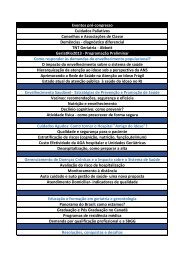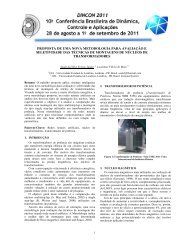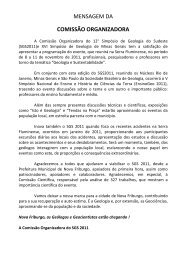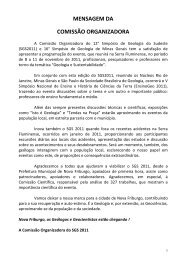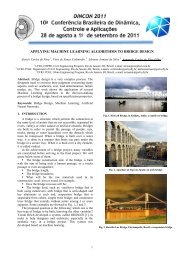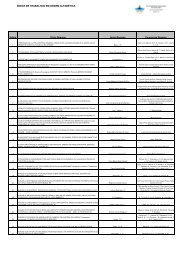Here - Meta Marketing e Eventos
Here - Meta Marketing e Eventos
Here - Meta Marketing e Eventos
- No tags were found...
Create successful ePaper yourself
Turn your PDF publications into a flip-book with our unique Google optimized e-Paper software.
22 nd Salt Water Intrusion Meeting: Salt Water Intrusion in Aquifers: Challenges and PerspectivesGozo are small carbonate islands with a freshwater lens floating on a continuous marinegroundwater body. In other small islands more complex situations exist, which include deepkarstified formation combined with active volcanism. The small volcanic islands oftencontain a low permeability core, but actual information is often poor.In the Atlantic ocean, the most important small islands are those of the MacaronesianArchipelago (Azores, Madeira, Canary and Cap Vert archipelagos), to which Fornando deNoronha island can be added (close to Brasil). They are fully volcanic and seawater problemsare limited to small –although locally important– aquifers (Custodio, 2010b). Many of themare in the arid Saharan belt, while others are quite well recharged, including among themsome Caribbean islands such as Guadelupe and Montserrat, where seawater intrusion islimited to areas close to the shore.In the Pacific Ocean, the Galapagos islands are little known form the point of view ofseawater intrusion. In Easter (Pascua) island most wells, which are close to the coast, sufferfrom some salinization due to the high permeability of recent volcanics (Herrera andCustodio, 2008).3. COASTAL AQUIFER MANAGEMENT AND GOVERNANCEThe often numerous groundwater developers of coastal aquifers, a common circumstance ingroundwater, is a serious problem for management, and especially for groundwater qualitymanagement. This is an open field of research, technology and social–economic development,in which experience is currently very limited. In Europe two well–developed managementexamples are The Netherlands –especially the area of Amsterdam– and the Llobregat deltanear Barcelona, Spain, which emulate the decades–long experience in California and to someextent in Long Island, New York. In the Llobregat case, further to decided action by the waterauthority –even with a barrier to halt seawater intrusion by injecting highly treated reclaimedwater– a groundwater users association is effective in putting together all groundwater usersto deal with existing salinity problems.Interesting management cases are that of Mar del Plata, Argentina, and nearby areas, whereabstraction is mostly for town supply, and the Hermosillo plain, Sonora, mostly for irrigation,where salinization through upconing from deep formations is a serious problem.Sound management examples are scarce. Sharing experience taking into account localcircumstances is urgently needed to preserve coastal aquifers and their important role forsupply, agriculture, the environment and the ecological services. Regulations are needed,which have to be adequate for dealing with real situations and respond to actual needs. Theapplication and management is the role of public organizations and water authorities.However, their effectiveness and the possibility of dealing with large territories and the oftennumerous groundwater developers and stakeholders highly depend on their co–operation andco–responsibility, which needs them to be organized. Experience in California is encouragingbut may be difficult to translate into the administrative and legal systems existing in many ofthe European and Ibero–American countries. So developing specific methods is a wantedgoal, as was the case of the pioneering case of the Llobregat delta (Niñerola et al., 2009).15



